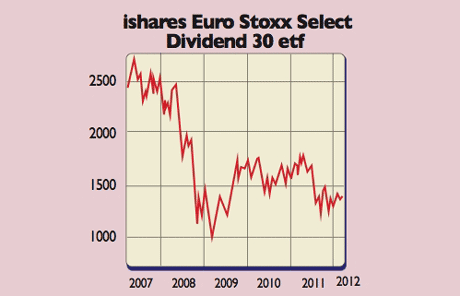The best ETF dividend funds
A dividend exchange-traded fund can be a great way to tap into a steady income stream. But what are the risks? Tim Bennett explains.
"Dividends are one of the few constants in the world of investing," says Hortense Bioy on Morningstar.com. Over the last decade they have made up just about all of the return from the FTSE 100 and since 1925 around 40% of the S&P 500.
One popular way to tap into a solid dividend income stream is via a dividend exchange-traded fund (ETF). The newest kids on this block are about to be launched by State Street with its UK and European Dividend Aristocrats ETFs. So what should investors watch out for?
Dividend ETFs offer a cheap, diversified fund that will track dividend-paying stocks and offer a decent yield at the same time. As an example, the ishares FTSE UK Dividend Plus ETF (IUKD) offers a juicy 6% yield and comes with an annual total expense ratio (TER) of just 0.4%.
MoneyWeek
Subscribe to MoneyWeek today and get your first six magazine issues absolutely FREE

Sign up to Money Morning
Don't miss the latest investment and personal finances news, market analysis, plus money-saving tips with our free twice-daily newsletter
Don't miss the latest investment and personal finances news, market analysis, plus money-saving tips with our free twice-daily newsletter
Investors in emerging markets have cottoned on too the Wisdom Tree emerging-markets equity income fund offered a yield of more than 6% at the end of last year and is the ninth-fastest growing US ETF so far this year. The TER is 0.63%. Similar offerings are available from State Street and BlackRock. But before buying, be careful not all dividend ETFs are created equal.
First, look under the bonnet at the top fund holdings. The whole point of investing for income is to gain access to a steady, reliable cash flow and accept that you may be giving up big capital gains, at least in the short term. The fund fact sheet will tell you which sectors and firms the fund has bought.
Here's the catch high yield can also mean high risk. For example, the iShares FTSE ETF mentioned earlier targets the 50 highest-yielding FTSE 350 stocks and so holds a raft of insurance companies and travel operator TUI hardly risk-free sectors. Meanwhile, the Wisdom Tree emerging markets ETF is 25% invested in Taiwanese and Brazilian financials.
Next, check whether the fund uses a market capitalisation-weighting approach or caps the maximum size of a single holding to, say, 5%. The danger with the first approach is that it can result in a few risky stocks making up a disproportionately large chunk of the fund.
The best route to a safe yield is to pick ETFs that focus on stocks that are likely to be able to sustain or raise their dividends. The US Vanguard Dividend appreciation ETF (VIG) looks for stocks with a ten-year track record of raising dividends. In Europe, the iShares Euro Stoxx Select Dividend 30 ETF (IDVY) only buys firms with a five-year track record of dividend per share growth.

Get the latest financial news, insights and expert analysis from our award-winning MoneyWeek team, to help you understand what really matters when it comes to your finances.
Tim graduated with a history degree from Cambridge University in 1989 and, after a year of travelling, joined the financial services firm Ernst and Young in 1990, qualifying as a chartered accountant in 1994.
He then moved into financial markets training, designing and running a variety of courses at graduate level and beyond for a range of organisations including the Securities and Investment Institute and UBS. He joined MoneyWeek in 2007.
-
 How gifting money this Christmas could lower your inheritance tax bill
How gifting money this Christmas could lower your inheritance tax billCash is an easy and quick present to give over Christmas – and it could protect some of your estate from the taxman down the line
-
 £100 contactless card limit to be lifted
£100 contactless card limit to be liftedConsumers will be able to set their own contactless limits from March 2026, under new rules from the Financial Conduct Authority